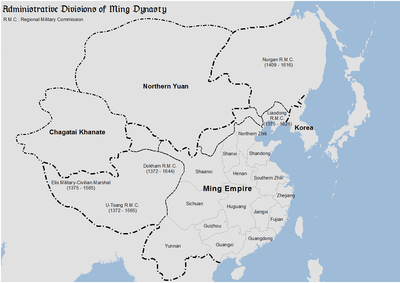Nurgan Regional Military Commission
The Nurgan Regional Military Commission (Chinese: 奴兒干都指揮使司; pinyin: Nú'érgān dūzhǐhuī shǐsī) was a Chinese administrative seat established in Manchuria during the Ming dynasty, located on the banks of the Amur River, about 100 km from the sea, at Nurgan city (modern Tyr, Russia), Nurgan (
Nurgan Regional Military Commission 奴兒干都指揮使司 | |
|---|---|
| 1409–1435 | |
 Administrative divisions of Ming dynasty in 1409; Nurgan Regional Military Commission is in the northeast. | |
| Capital | Tyr |
| Common languages | Chinese, Jurchen |
| Historical era | Ming Dynasty |
• Established | 1409 |
• Dissolved | 1435 |
By 1409, the Yongle Emperor's government, which had already established relations with the Haixi and Jianzhou Jurchens in southern Manchuria, ordered Yishiha to start preparations for an expedition to the lower Amur River region, to demonstrate the power of the Ming Empire to the Nurgan Jurchen populating the area and induce them to enter into relations with the empire, and to ensure that they would not create trouble for the Ming state when the latter went to war with the Eastern Mongols.[7]
In 1413 Yishiha also visited the nearby coast of the Sakhalin Island, and granted Ming titles to a local chieftain.[6]
Some sources report a Chinese fort existed at Aigun for about 20 years during the Yongle era on the left (northwestern) shore of the Amur downstream from the mouth of the Zeya River. This Ming Dynasty Aigun was located on the opposite bank to the later Aigun that was relocated during the Qing Dynasty.[8]
Yishiha's last mission was connected to the retirement of the Nurgan chief and the "inauguration" of his son as his successor. Yishiha attended at that event in 1432, presenting the new chief a seal of authority and giving gifts to subordinate chieftains.[7][9] This time Yishiha's fleet included 50 big ships with 2,000 soldiers, and they actually brought the new chief (who had been living in Beijing) to Tyr.[10]
See also
References
- "明代为何称辽东以北为奴儿干(Nurgan)?这个词源出何处? – 知乎". www.zhihu.com. Retrieved 11 April 2016.
- Li, Gertraude Roth (2002). "State Building before 1644". In Peterson, Willard J. (ed.). The Ch'ing Empire to 1800. Cambridge History of China. 9. Cambridge University Press. p. 14. ISBN 978-0-521-24334-6.
- Crossley, Pamela Kyle (2002). A Translucent Mirror: History and Identity in Qing Imperial Ideology. University of California Press. pp. 58, 185. ISBN 978-0-520-23424-6.
- Jin, Guangping; Jin, Qizong (1980). 女真語言文字研究 [Study of Jurchen Language and Script]. Wenwu Chubaneshe. p. 355.
- L. Carrington Godrich, Chaoying Fang (editors), "Dictionary of Ming Biography, 1368–1644". Volume I (A-L). Columbia University Press, 1976. ISBN 0-231-03801-1
- Tsai, Shih-Shan Henry (2002). Perpetual Happiness: The Ming Emperor Yongle. University of Washington Press. pp. 158–159. ISBN 0-295-98124-5.
- Rossabi, Morris (1976). "Isiha". In Goodrich, L. Carrington; Fang, Chaoying (eds.). Dictionary of Ming Biography, 1368–1644. Volume I (A-L). Columbia University Press. pp. 685–686. ISBN 0-231-03801-1.
- Du Halde, Jean-Baptiste (1735). Description géographique, historique, chronologique, politique et physique de l'empire de la Chine et de la Tartarie chinoise. Volume IV. Paris: P.G. Lemercier. pp. 15–16. Numerous later editions are available as well, including one on Google Books. Du Halde refers to the Yongle-era fort, the predecessor of Aigun, as Aykom. There seem to be few, if any, mentions of this project in other available literature.
- Tsai (1996) describes the person being retired as "the commissioner in chief Kang Wang"; one has to assume that it was a Chinese title, and Chinese name, bestowed to a local (probably, Nivkh) chief.
- Tsai, Shih-Shan Henry (1996). The Eunuchs in the Ming Dynasty. SUNY Press. pp. 129–130. ISBN 0-7914-2687-4.
.png)